Module7 Unit 2
- 格式:ppt
- 大小:1.60 MB
- 文档页数:31
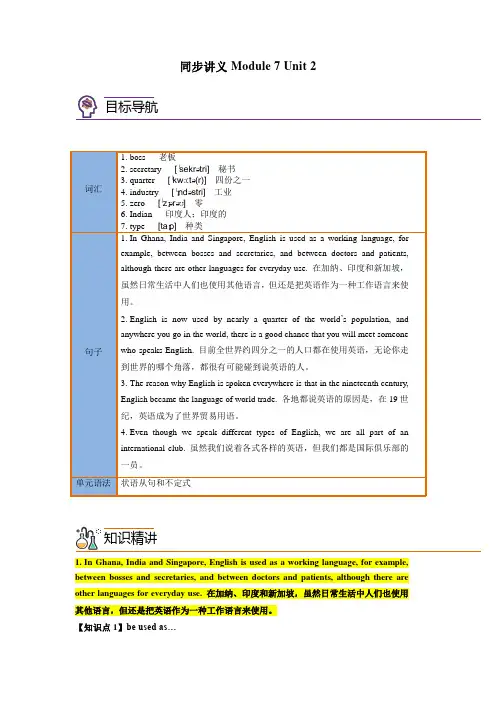
同步讲义 Module 7 Unit 2词汇1. boss 老板2. secretary [ˈsekr ətri] 秘书3. quarter [ˈkw ɔ:t ə(r)] 四份之一4. industry [ˈɪnd əstri] 工业5. zero [ˈz ɪər əʊ] 零6. Indian 印度人;印度的7. type [ta ɪp] 种类句子1. In Ghana, India and Singapore, English is used as a working language, for example, between bosses and secretaries, and between doctors and patients, although there are other languages for everyday use. 在加纳、印度和新加坡,虽然日常生活中人们也使用其他语言,但还是把英语作为一种工作语言来使用。
2. English is now used by nearly a quarter of the world ’s population, and anywhere you go in the world, there is a good chance that you will meet someonewho speaks English. 目前全世界约四分之一的人口都在使用英语,无论你走到世界的哪个角落,都很有可能碰到说英语的人。
3. The reason why English is spoken everywhere is that in the nineteenth century, English became the language of world trade. 各地都说英语的原因是,在19世纪,英语成为了世界贸易用语。
4. Even though we speak different types of English, we are all part of an international club. 虽然我们说着各式各样的英语,但我们都是国际俱乐部的一员。
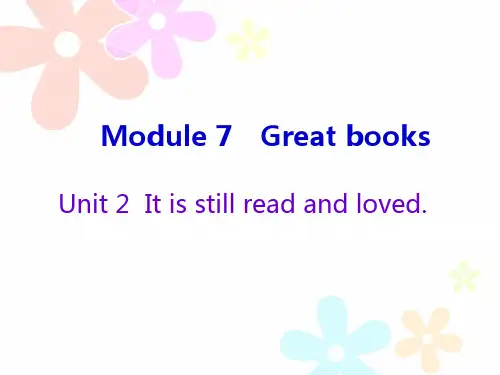
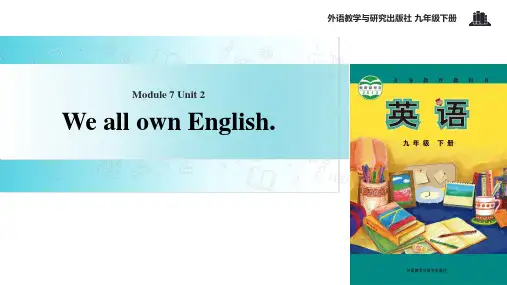
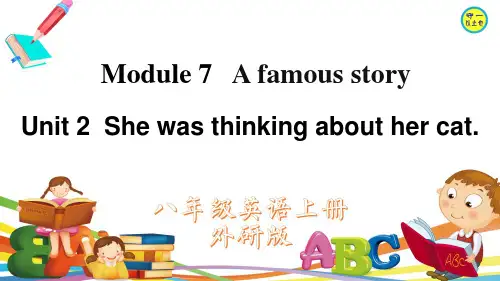
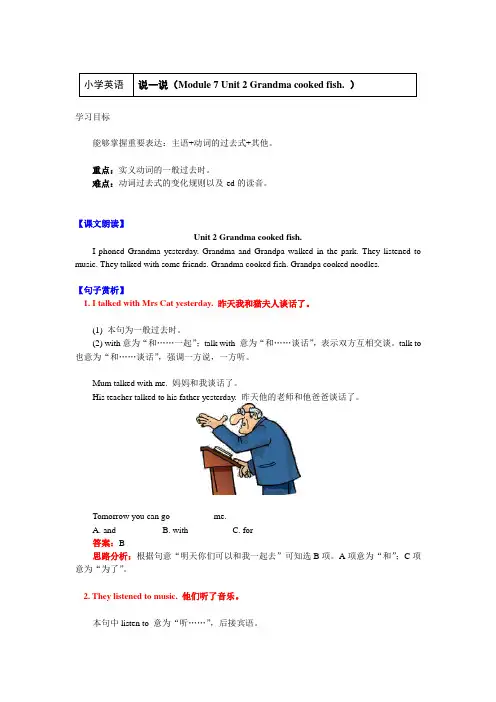
小学英语说一说(Module 7 Unit 2 Grandma cooked fish. )学习目标能够掌握重要表达:主语+动词的过去式+其他。
重点:实义动词的一般过去时。
难点:动词过去式的变化规则以及-ed的读音。
【课文朗读】Unit 2 Grandma cooked fish.I phoned Grandma yesterday. Grandma and Grandpa walked in the park. They listened to music. They talked with some friends. Grandma cooked fish. Grandpa cooked noodles.【句子赏析】1. I talked with Mrs Cat yesterday. 昨天我和猫夫人谈话了。
(1) 本句为一般过去时。
(2) with意为“和……一起”;talk with 意为“和……谈话”,表示双方互相交谈。
talk to 也意为“和……谈话”,强调一方说,一方听。
Mum talked with me. 妈妈和我谈话了。
His teacher talked to his father yesterday. 昨天他的老师和他爸爸谈话了。
Tomorrow you can go _________ me.A. andB. withC. for答案:B思路分析:根据句意“明天你们可以和我一起去”可知选B项。
A项意为“和”;C项意为“为了”。
2. They listened to music. 他们听了音乐。
本句中listen to 意为“听……”,后接宾语。
listened是动词listen的过去式。
过去式的变化有几种,现介绍其中的四种:规则动词的变化方法:(1) 一般的直接在动词后加-ed,如:talk→ talked;cook → cooked。
(2) 以不发音的字母e结尾的,在动词后加-d,如:dance → danced;phone→ phoned。
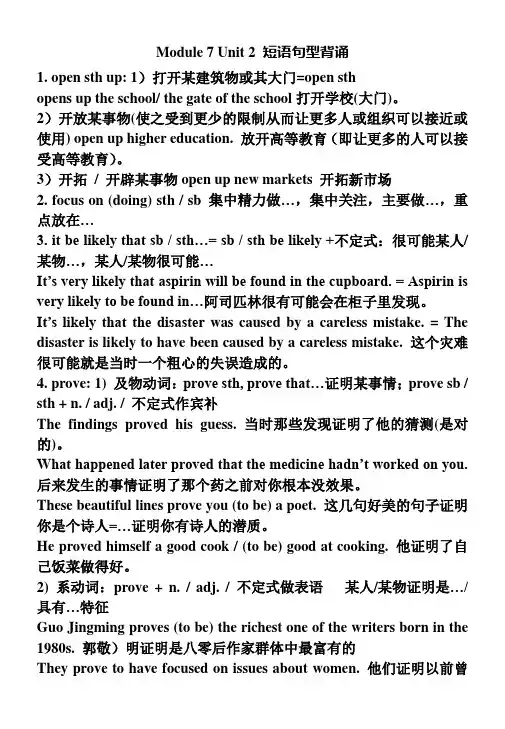
Module 7 Unit 2 短语句型背诵1. open sth up: 1)打开某建筑物或其大门=open sthopens up the school/ the gate of the school打开学校(大门)。
2)开放某事物(使之受到更少的限制从而让更多人或组织可以接近或使用) open up higher education. 放开高等教育(即让更多的人可以接受高等教育)。
3)开拓/ 开辟某事物open up new markets 开拓新市场2. focus on (doing) sth / sb 集中精力做…,集中关注,主要做…,重点放在…3. it be likely that sb / sth…= sb / sth be likely +不定式:很可能某人/某物…,某人/某物很可能…It’s very likely that aspirin will be found in the cupboard. = Aspirin is very likely to be found in…阿司匹林很有可能会在柜子里发现。
It’s likely that the disaste r was caused by a careless mistake. = The disaster is likely to have been caused by a careless mistake. 这个灾难很可能就是当时一个粗心的失误造成的。
4. prove: 1) 及物动词:prove sth, prove that…证明某事情;prove sb / sth + n. / adj. / 不定式作宾补The findings proved his guess. 当时那些发现证明了他的猜测(是对的)。
What happened later proved that the medicine hadn’t worked on you. 后来发生的事情证明了那个药之前对你根本没效果。
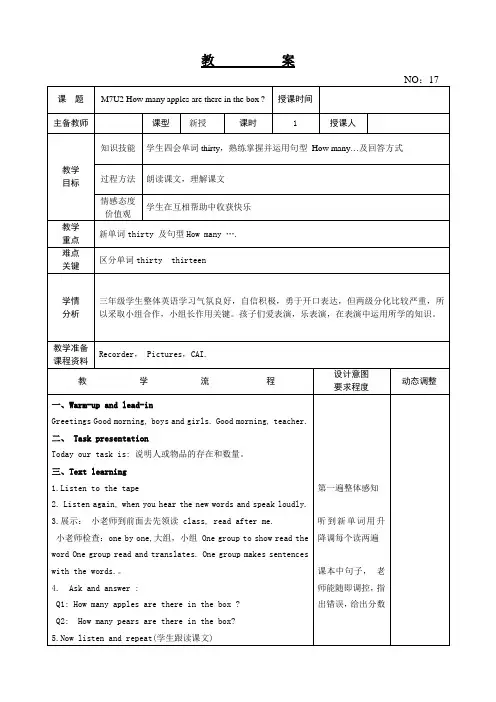
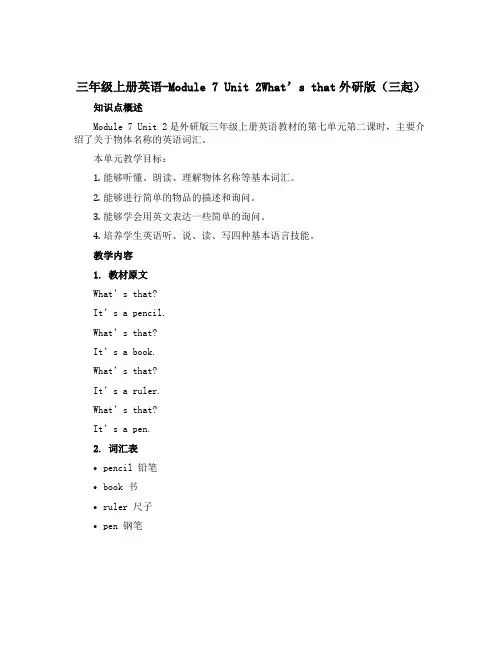
三年级上册英语-Module 7 Unit 2What’s that外研版(三起)知识点概述Module 7 Unit 2是外研版三年级上册英语教材的第七单元第二课时,主要介绍了关于物体名称的英语词汇。
本单元教学目标:1.能够听懂、朗读、理解物体名称等基本词汇。
2.能够进行简单的物品的描述和询问。
3.能够学会用英文表达一些简单的询问。
4.培养学生英语听、说、读、写四种基本语言技能。
教学内容1. 教材原文What’s that?It’s a pencil.What’s that?It’s a book.What’s that?It’s a ruler.What’s that?It’s a pen.2. 词汇表•pencil 铅笔•book 书•ruler 尺子•pen 钢笔教学过程1. Class opening老师可以带着学生通过不同的图片和道具进行识物和学习新单词,并从学生中挑选一些同学来描述这些物品。
2. 阅读原文老师可以大声读出原文,学生跟着朗读,并在课堂上进行简单的问答练习。
3. 学生练习老师可以让学生进行语音练习,朗读的时候注重发音,语感,注意单句语调的上升下降,练习语音的连贯性和自然度,以更好地理解和记忆单词的发音以及语音练习。
4. 角色扮演老师可以安排学生们分成小组,进行简单的英语角色扮演,在角色扮演中学生可以通过马上语言打破自己的抑制,勇于开口,勤于思考,让学生理解和掌握物品的名称。
总结本单元主要学习了一些日常使用物品的英文名称,多练习和加强的是听,说和读的技能。
同学们在课堂上通过老师和同学的帮助,不断强化对英语语音和文化的接受和理解,渐渐地感受到学习英语的乐趣。
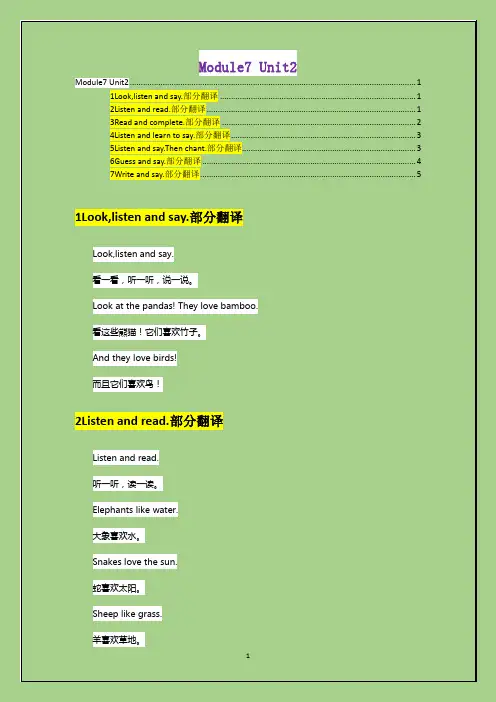
Module7 Unit2Module7 Unit2 (1)1Look,listen and say.部分翻译 (1)2Listen and read.部分翻译 (1)3Read and complete.部分翻译 (2)4Listen and learn to say.部分翻译 (3)5Listen and say.Then chant.部分翻译 (3)6Guess and say.部分翻译 (4)7Write and say.部分翻译 (5)1Look,listen and say.部分翻译Look,listen and say.看一看,听一听,说一说。
Look at the pandas! They love bamboo.看这些熊猫!它们喜欢竹子。
And they love birds!而且它们喜欢鸟!2Listen and read.部分翻译Listen and read.听一听,读一读。
Elephants like water.大象喜欢水。
Snakes love the sun.蛇喜欢太阳。
Sheep like grass.羊喜欢草地。
Bears like to sleep in winter.熊喜欢在冬天睡觉。
Dogs like playing with children.狗喜欢和孩子们玩耍。
Pandas love bamboo.熊猫喜欢竹子。
3Read and complete.部分翻译Read and complete.读一读并完成。
believe相信eat吃love喜欢Look at看sleep睡觉1 Bears like to_____in winter,but dogs don't.1熊喜欢在冬天_____,但是狗不喜欢。
2 Monkeys like to_____bananas and pandas _____bamboo.2 猴子喜欢____香蕉,熊猫_____竹子。
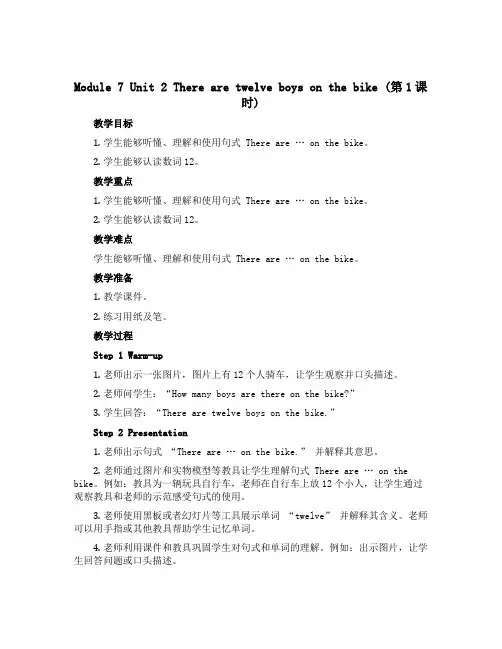
Module 7 Unit 2 There are twelve boys on the bike (第1课时)教学目标1.学生能够听懂、理解和使用句式There are … on the bike。
2.学生能够认读数词12。
教学重点1.学生能够听懂、理解和使用句式There are … on the bike。
2.学生能够认读数词12。
教学难点学生能够听懂、理解和使用句式There are … on the bike。
教学准备1.教学课件。
2.练习用纸及笔。
教学过程Step 1 Warm-up1.老师出示一张图片,图片上有12个人骑车,让学生观察并口头描述。
2.老师问学生:“How many boys are there on the bike?”3.学生回答:“There are twelve boys on the bike.”Step 2 Presentation1.老师出示句式“There are … on the bike.” 并解释其意思。
2.老师通过图片和实物模型等教具让学生理解句式There are … on the bike。
例如:教具为一辆玩具自行车,老师在自行车上放12个小人,让学生通过观察教具和老师的示范感受句式的使用。
3.老师使用黑板或者幻灯片等工具展示单词“twelve” 并解释其含义。
老师可以用手指或其他教具帮助学生记忆单词。
4.老师利用课件和教具巩固学生对句式和单词的理解。
例如:出示图片,让学生回答问题或口头描述。
Step 3 Practice1.老师将“There are twelve boys on the bike.” 分别抹去其中的词汇,并在黑板、幻灯片等工具上让学生补全句子(例如只留下“There are … boys on the bike.” 让学生补全数字“twelve”)。
2.老师为学生出示多张图片,让学生口头描述每张图片中出现了多少个人或物品。
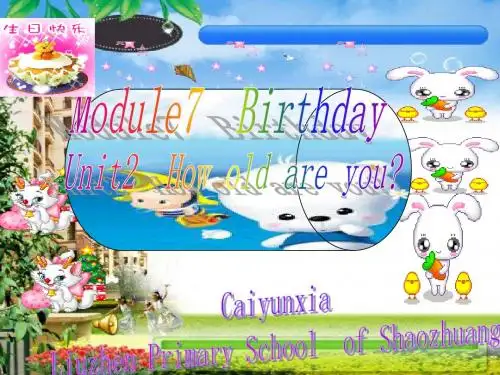
外研版九年级下册英语Module7Unit2部分课文翻译外研版九年级下册英语Module7 Unit2部分课文翻译(一) where they are它们所在的地方what languages you can see你能看到的语言1.How many people in the world use English?世界上有多少人使用英语?2.How did English bee an international language?英语是如何成为一门国际语言的?3.When do you think Chinese will bee an international language?你认为什么时候汉语会成为一门国际语言?4.Who owns English?谁拥有英语?Who owns English?谁拥有英语?English is spoken by about 400 million people,mostlyin the US, the UK, Canada, Australia, New Zealand and South Africa. In Ghana,India and Singapore , Englishis used as a working language, for example, between bosses and secretaries and between doctors and patients,although there are other languages for everyday use.In China and many other countries,English is the. most important toreign language that children learn at school, because when they grow up, it will be quite possible for them to meet people from other countries. They will need a mon language to municate with each other. English is now used by nearly a quarter of the world's population,and anywhere you go in the world,there is a good chance that you will meet someone who speaks English.大约有4亿人说英语,主要在美国、英国、加拿大、澳大利亚、新西兰和南非。
Module 7 unit2 It is still read and loved.教案外研版九年级上册Module 7 unit2 It is still read and loved.教案Lesson Objective:By the end of the lesson, students will be able to:Understand the significance and enduring popularity of classical literature in Chinese culture.Analyze the themes, characters, and messages conveyed in selected classical literary works.Appreciate the value and beauty of classical literature and its relevance in contemporary society.Materials:Whiteboard, markers, and eraserHandouts with excerpts from classical Chinese literatureAudio or video materials featuring recitations or discussions of classical literary worksWarm-up Activity :Begin the lesson by asking students about their favorite books or literary works.Discuss the importance of literature in preserving cultural heritage and promoting understanding among people.Introduce the concept of classical literature and its significance inChinese culture.IntroductionPresent examples of well-known classical Chinese literary works, such as “Dream of the Red Chamber,” “Journey to the West,” or “Romance of the Three Kingdoms.”Provide a brief overview of the selected literary works, highlighting their historical context and cultural importance.Engage students in a discussion about their initial impressions and expectations of classical literature.Literary Analysis :Distribute handouts with excerpts from one or two classical literary works.Instruct students to read the excerpts individually or in pairs and identify key themes, characters, and messages conveyed in the text.Facilitate a class discussion, allowing students to share their observations and interpretations.Write down key points on the whiteboard to summarize the analysis of the selected excerpts.Discussion and Reflection:Divide students into small groups and provide them with discussion questions related to the value and relevance of classical literature. Instruct the groups to discuss the enduring popularity of classical literaryworks and the reasons why they are still read and loved today. Encourage students to share personal experiences or cultural references that demonstrate the ongoing influence of classical literature in contemporary society.Rotate groups and facilitate class discussions, allowing students to exchange ideas and perspectives.Example discussion questions:What do you think makes classical Chinese literature timeless and beloved by readersHow do the themes and messages conveyed in classical works resonate with people’s lives todayWhat can we learn from classical literature and how can it help us understand our cultural heritageWrap-up and Appreciation:Summarize the main points discussed during the lesson, emphasizing the enduring value and importance of classical Chinese literature.Invite students to express their appreciation for classical literary works by sharing their favorite excerpts or passages from the texts. Encourage students to explore more classical literature beyond the classroom, either through reading books or watching adaptations in film or theater.Provide additional resources or suggestions for further exploration ofclassical Chinese literature, such as recommended books or online platforms featuring literary discussions or analyses.。
四年级上册英语教案-Module 7 Unit 2 There are twelve boyson the bike 外研版(三起)教材分析本教材为四年级上册英语教材的第七个模块,第二个单元所使用的教材为外研版(三起)。
本单元主要通过介绍人物、自行车和数字来帮助学生掌握英语数字的用法以及基本的英语句式。
教学内容本节课教学的内容主要包括以下几个方面:1.复习数字1-10的表达方式。
2.练习使用数字0-12进行计数。
3.学习新单词bike(自行车)、boys(男孩)。
4.学习句式“There are twelve boys on the bike.”(自行车上有十二个男孩。
)。
5.练习句子的口语表达和书写。
教学目标1.学生能够听、说、读、写数字0-12.2.学生能够听懂和说出新单词bike和boys。
3.学生能够理解并使用句式“There are twelve boys on the bike.”。
4.学生能够通过听力、口语和书写练习来掌握数字、单词和句型的使用。
教学重点1.学生能够正确使用数字0-12进行计数。
2.学生能够使用新单词bike和boys。
3.学生能够正确使用句式“There are twelve boys on the bike.”。
教学步骤1.热身:用10以内的数字互相询问年龄,比如问“Are you 6 years old?” ,回答“Yes, I am.”。
2.小组活动:请学生用数字0-12进行计数,每组需要有一名学生领读数字。
3.新单词学习:学生跟随教师学习新单词bike和boys,并在黑板上写出单词和发音。
4.句子学习:教师介绍新句式“There are twelve boys on the bike.”,并要求学生一遍一遍地模仿,并帮助他们理解句子含义。
5.游戏练习:教师进行游戏练习,比如让学生用数字描述自己的家庭成员。
6.书写练习:学生在作业本上写下所学数字和句子,并进行检查。